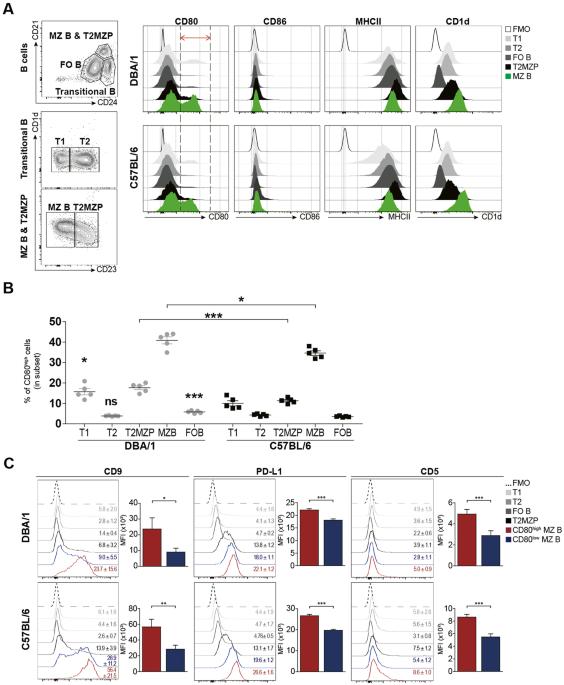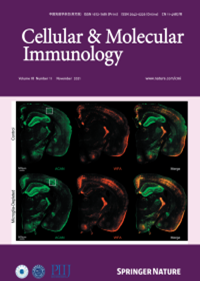Two distinct subpopulations of marginal zone B cells exhibit differential antibody-producing capacities and radioresistance
IF 21.8
1区 医学
Q1 IMMUNOLOGY
引用次数: 0
Abstract
Marginal zone (MZ) B cells, which are splenic innate-like B cells that rapidly secrete antibodies (Abs) against blood-borne pathogens, are composed of heterogeneous subpopulations. Here, we showed that MZ B cells can be divided into two distinct subpopulations according to their CD80 expression levels. CD80high MZ B cells exhibited greater Ab-producing, proliferative, and IL-10-secreting capacities than did CD80low MZ B cells. Notably, CD80high MZ B cells survived 2-Gy whole-body irradiation, whereas CD80low MZ B cells were depleted by irradiation and then repleted with one month after irradiation. Depletion of CD80low MZ B cells led to accelerated development of type II collagen (CII)-induced arthritis upon immunization with bovine CII. CD80high MZ B cells exhibited higher expression of genes involved in proliferation, plasma cell differentiation, and the antioxidant response. CD80high MZ B cells expressed more autoreactive B cell receptors (BCRs) that recognized double-stranded DNA or CII, expressed more immunoglobulin heavy chain sequences with shorter complementarity-determining region 3 sequences, and included more clonotypes with no N-nucleotides or with B-1a BCR sequences than CD80low MZ B cells. Adoptive transfer experiments showed that CD21+CD23+ transitional 2 MZ precursors preferentially generated CD80low MZ B cells and that a proportion of CD80low MZ B cells were converted into CD80high MZ B cells; in contrast, CD80high MZ B cells stably remained CD80high MZ B cells. In summary, MZ B cells can be divided into two subpopulations according to their CD80 expression levels, Ab-producing capacity, radioresistance, and autoreactivity, and these findings may suggest a hierarchical composition of MZ B cells with differential stability and BCR specificity.


边缘区 B 细胞的两个不同亚群表现出不同的抗体生成能力和放射抗性。
边缘区(MZ)B细胞是脾脏先天性B细胞,能快速分泌抗体(Abs)对抗血源性病原体,它由不同的亚群组成。在这里,我们发现 MZ B 细胞可根据其 CD80 表达水平分为两个不同的亚群。与 CD80 低的 MZ B 细胞相比,CD80 高的 MZ B 细胞具有更强的抗体生成、增殖和 IL-10 分泌能力。值得注意的是,CD80高的MZ B细胞能在2-Gy全身辐照后存活,而CD80低的MZ B细胞则会因辐照而耗竭,并在辐照一个月后重新耗竭。CD80低MZ B细胞的耗竭导致牛CII免疫后II型胶原蛋白(CII)诱导的关节炎加速发展。CD80 高的 MZ B 细胞在涉及增殖、浆细胞分化和抗氧化反应的基因中表现出更高的表达量。与 CD80 低的 MZ B 细胞相比,CD80 高的 MZ B 细胞表达更多识别双链 DNA 或 CII 的自反应性 B 细胞受体(BCR),表达更多具有较短互补决定区 3 序列的免疫球蛋白重链序列,并包含更多无 N 核苷酸或具有 B-1a BCR 序列的克隆型。采用性转移实验表明,CD21+CD23+过渡性2 MZ前体优先生成CD80低MZ B细胞,一部分CD80低MZ B细胞转化为CD80高MZ B细胞;相比之下,CD80高MZ B细胞稳定地保持为CD80高MZ B细胞。总之,MZ B细胞可根据其CD80表达水平、Ab生成能力、放射抗性和自反应性分为两个亚群,这些发现可能表明MZ B细胞的组成是分层的,具有不同的稳定性和BCR特异性。
本文章由计算机程序翻译,如有差异,请以英文原文为准。
求助全文
约1分钟内获得全文
求助全文
来源期刊
CiteScore
31.20
自引率
1.20%
发文量
903
审稿时长
1 months
期刊介绍:
Cellular & Molecular Immunology, a monthly journal from the Chinese Society of Immunology and the University of Science and Technology of China, serves as a comprehensive platform covering both basic immunology research and clinical applications. The journal publishes a variety of article types, including Articles, Review Articles, Mini Reviews, and Short Communications, focusing on diverse aspects of cellular and molecular immunology.

 求助内容:
求助内容: 应助结果提醒方式:
应助结果提醒方式:


